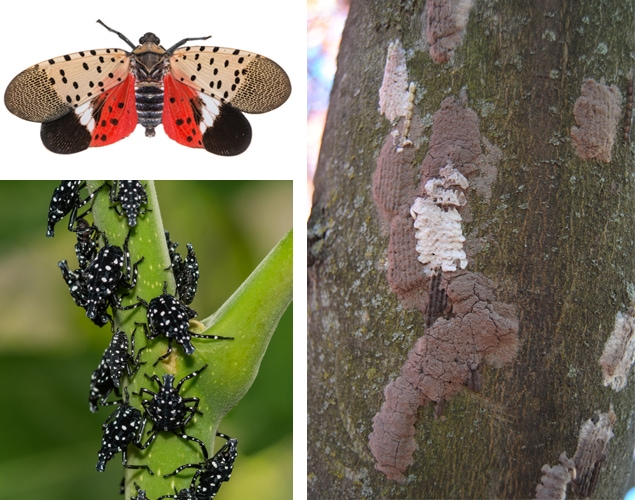
November – March is time to act
The invasive Spotted Lanternfly, Lycorma delicatula, originally native to East Asia, has emerged as a significant ecological threat, spreading its wings of concern and finding its way to new habitats, particularly in North America. Recognizable by its eye-catching appearance featuring vibrant red wings adorned with distinct black spots, the spotted lanternfly has become a serious nuisance.
Known for its voracious appetite, this invasive insect primarily feeds on the sap of a wide range of plants, including fruit trees, ornamental plants, and valuable hardwoods. This relentless feeding poses a direct threat to our beloved gardens, potentially resulting in significant damage.
The destruction doesn’t stop at the feeding—it leaves behind a sticky residue called honeydew. This honeydew not only attracts other pests but also encourages the growth of sooty mold, creating an unsightly and unhealthy environment for plants.
Spotted Lanternfly egg masses are laid in the fall, survive through the winter, and then hatch in the spring. Each egg mass contains 30-50 eggs, so finding and destroying these egg masses properly might lessen populations.
Taking action during the insect’s dormancy period from November to March is especially crucial, ensuring that hatching is thwarted and the potential for infestation is minimized, safeguarding the health and vitality of your plants.
Mitigating the Spotted Lanternfly requires proactive measures, particularly during its dormancy period from November to March, weather dependent. An effective approach involves the careful identification and removal of egg masses. Gardeners and arborists are advised to scrape off these egg masses diligently, disposing of them to prevent the hatching of future generations. Alternatively, applying a dormant oil spray proves to be a strategic preventive measure during this dormant phase, offering an additional layer of defense against the invasive insect’s lifecycle. By incorporating these practices into routine garden maintenance during the winter months, homeowners and gardeners can play a crucial role in lessening populations of the Spotted Lanternfly.
Increased vigilance, early detection, and prompt action may help to lessen the lanternfly’s impact on healthy plants.
Ultimately, it’s important to understand that the spotted lanternfly is a nuisance pest that is difficult to control. In our experience, we have found that the NYS DEC approved methods that we use, help to control populations.
